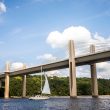New York sports fields get a makeover
Eleven athletic fields on New York City’s Randall’s Island have been rebuilt with synthetic turf. The project, which covers 1.1 million square feet, will boost the number of sports fields in Manhattan by 30 percent.
The Randall’s Island Sports Foundation, which is a public-private partnership, and the New York City Department of Parks and Recreation are leading the turf upgrade project. Eventually, more than 65 athletic fields will be renovated on Randall’s Island, which is part of the borough of Manhattan. The project, first conceived nearly seven years ago, is about 65 percent complete.
Fields get intense workout; stand up to heavy traffic
“There are so many new youth soccer programs, and the young adult athletic programs on the island have been doubling or tripling in size, so the fields are in constant use, throughout the year,” said Amy Brackin, director of marketing for Wayne, Pa.-based Sprinturf.
Brackin told GovPro.com that the renovated fields, which feature the company’s Ultrablade DF synthetic turf with a CoolFill infill system, will accommodate a variety of sports, including soccer, lacrosse, rugby, field hockey, football, baseball and softball.
Before the upgrade, athletes were constantly frustrated when wet weather closed the fields, often for more than a day, to preserve the grass. Other advantages of the synthetic product:
–The fields are uniform and provide a level playing surface.
–The synthetic turf system provides stable footing for athletes and helps reduce turf burns.
–Drainage is adequate; even in very wet conditions, there’s no standing water on the fields.
–The fields will be green year-round, and new lighting will lengthen the playing days.
City administrators believe the synthetic turf can save hundreds of thousands of dollars each year in reduced field maintenance costs. The synthetic sports surface eliminates the need for pesticides and fertilizers.
Brackin sees more communities considering synthetic turf in the current challenging economic times: “Sometimes you really can’t sustain natural grass, and if you are going to make the investments in sod or something of that nature, the incremental additional cost for synthetic will provide a much longer life span and a consistent environment that can endure the 24/7 play that these fields are getting. That’s where we are really seeing the drive towards synthetics.”




















